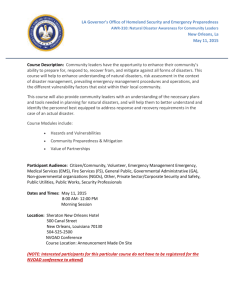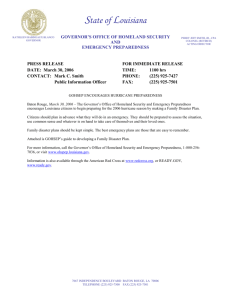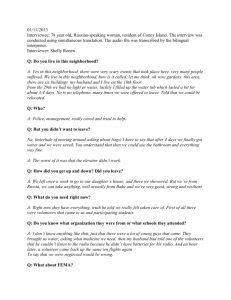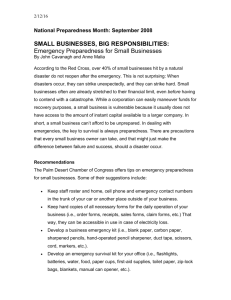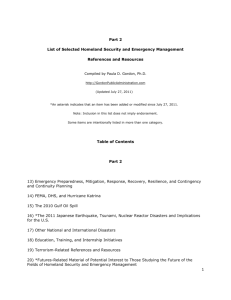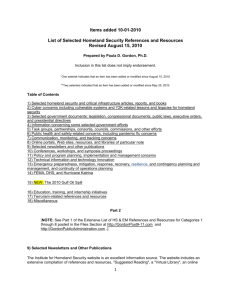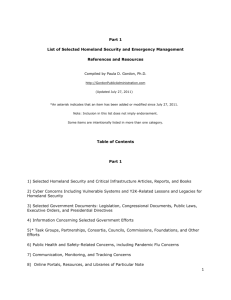INTERNET RESOURCES Crisis, disaster, and emergency
advertisement
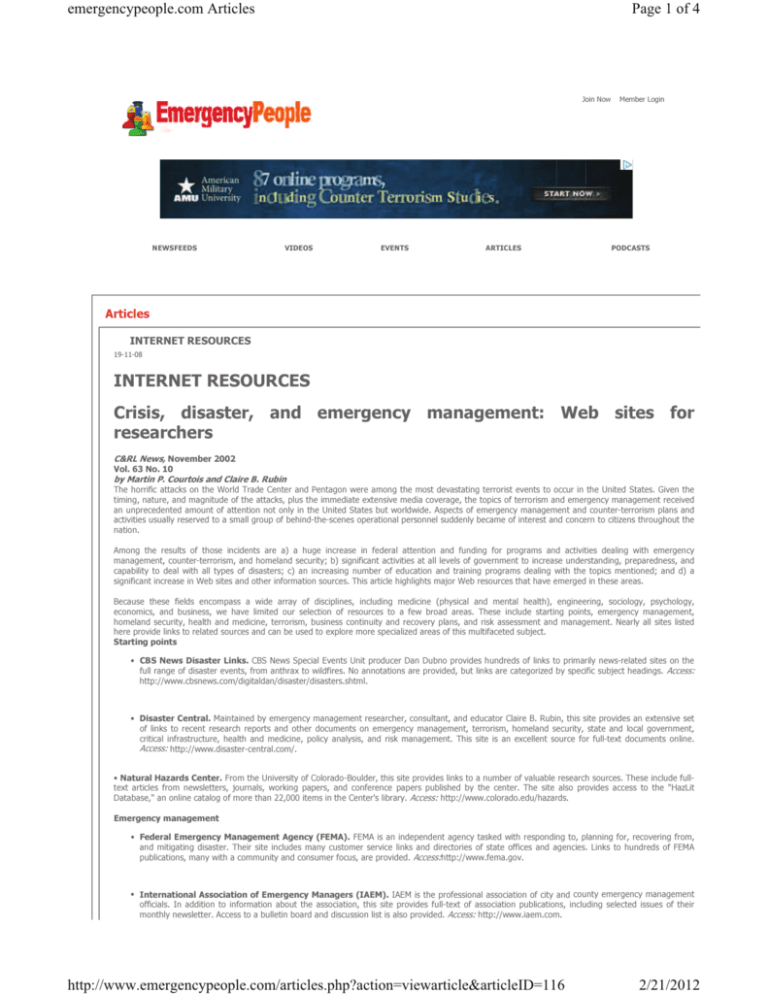
emergencypeople.com Articles Page 1 of 4 Join Now NEWSFEEDS VIDEOS EVENTS ARTICLES Member Login PODCASTS Articles INTERNET RESOURCES 19-11-08 INTERNET RESOURCES Crisis, disaster, and emergency management: Web sites for researchers C&RL News, November 2002 Vol. 63 No. 10 by Martin P. Courtois and Claire B. Rubin The horrific attacks on the World Trade Center and Pentagon were among the most devastating terrorist events to occur in the United States. Given the timing, nature, and magnitude of the attacks, plus the immediate extensive media coverage, the topics of terrorism and emergency management received an unprecedented amount of attention not only in the United States but worldwide. Aspects of emergency management and counter-terrorism plans and activities usually reserved to a small group of behind-the-scenes operational personnel suddenly became of interest and concern to citizens throughout the nation. Among the results of those incidents are a) a huge increase in federal attention and funding for programs and activities dealing with emergency management, counter-terrorism, and homeland security; b) significant activities at all levels of government to increase understanding, preparedness, and capability to deal with all types of disasters; c) an increasing number of education and training programs dealing with the topics mentioned; and d) a significant increase in Web sites and other information sources. This article highlights major Web resources that have emerged in these areas. Because these fields encompass a wide array of disciplines, including medicine (physical and mental health), engineering, sociology, psychology, economics, and business, we have limited our selection of resources to a few broad areas. These include starting points, emergency management, homeland security, health and medicine, terrorism, business continuity and recovery plans, and risk assessment and management. Nearly all sites listed here provide links to related sources and can be used to explore more specialized areas of this multifaceted subject. Starting points • CBS News Disaster Links. CBS News Special Events Unit producer Dan Dubno provides hundreds of links to primarily news-related sites on the full range of disaster events, from anthrax to wildfires. No annotations are provided, but links are categorized by specific subject headings. Access: http://www.cbsnews.com/digitaldan/disaster/disasters.shtml. • Disaster Central. Maintained by emergency management researcher, consultant, and educator Claire B. Rubin, this site provides an extensive set of links to recent research reports and other documents on emergency management, terrorism, homeland security, state and local government, critical infrastructure, health and medicine, policy analysis, and risk management. This site is an excellent source for full-text documents online. Access: http://www.disaster-central.com/. • Natural Hazards Center. From the University of Colorado-Boulder, this site provides links to a number of valuable research sources. These include fulltext articles from newsletters, journals, working papers, and conference papers published by the center. The site also provides access to the "HazLit Database," an online catalog of more than 22,000 items in the Center's library. Access: http://www.colorado.edu/hazards. Emergency management • Federal Emergency Management Agency (FEMA). FEMA is an independent agency tasked with responding to, planning for, recovering from, and mitigating disaster. Their site includes many customer service links and directories of state offices and agencies. Links to hundreds of FEMA publications, many with a community and consumer focus, are provided. Access:http://www.fema.gov. • International Association of Emergency Managers (IAEM). IAEM is the professional association of city and county emergency management officials. In addition to information about the association, this site provides full-text of association publications, including selected issues of their monthly newsletter. Access to a bulletin board and discussion list is also provided. Access: http://www.iaem.com. http://www.emergencypeople.com/articles.php?action=viewarticle&articleID=116 2/21/2012 emergencypeople.com Articles Page 2 of 4 • National Emergency Management Association (NEMA). NEMA is a professional association for state-level emergency management officials. The NEMA online library provides full-text access to more than 300 committee reports, position papers, training manuals, and implementation plans. A directory of emergency management contacts by state is also available. Access: http://www.nemaweb.org. • National Response Team (NRT). NRT is part of the National Response System for emergency response to discharges of oil and releases of chemicals. This site includes full-text access to more than 50 fact sheets and planning guides from NRT committees as well as more than 100 links to preparedness and response sites. Access: http://www.nrt.org/. Homeland security • Anser Institute for Homeland Security. The Anser Institute is dedicated to enhancing public safety. Their site includes news items, commentary and analysis, full-text articles from Journal of Homeland Security and "Homeland Security Newsletter," links to related full-text documents, and a weekly e-mail bulletin. Access: http://www.homelandsecurity.org/. • Brookings Institution. This well-known think tank provides access to numerous reports on economics, foreign policy, and governance. Featured documents include "Protecting the American Homeland" and "Assessing the Department of Homeland Security." Many publications are available online at no cost, others are available for purchase. Access: http://www.brook.edu/. • Department of Homeland Security. This official White House site provides background information on the proposed department, including legislation, transcripts of speeches and online chats, and details on organizational structure. Links to other sites on homeland security policies and news are also included. Access: http://www.whitehouse.gov/deptofhomeland. • National Homeland Security Knowledge Base. This site provides an extensive set of links to U.S. and other government agencies as well as international and research organizations. Focus is on various threats to homeland security, including nuclear/radiological, biological, chemical, and explosives, as well as natural disasters. Access: http://www.twotigersonline.com/resources.html. Health and medical • Agency for Toxic Substances and Disease Registry (ATSDR). This site features many news and information sources on toxic substances. Highlights include ToxFAQs (a series of summaries about hazardous substances), HazDat (the database that provides information on the release of hazardous substances from Superfund sites and emergency events), and Minimal Risk Levels for hazardous substances. The "Science Corner" section of this site is a gateway to environmental health information and Web resources. Access: http://atsdr1.atsdr.cdc.gov/cx.html. • Bioterrorism Articles. This site from the American Medical Association is a collection of more than 100 full-text articles, primarily from JAMA and Morbidity and Mortality Weekly Report, on biological weapons agents such as anthrax, smallpox, and others. Articles cover clinical, epidemiological, preparedness, and policy aspects. Access: http://pubs.ama-assn.org/bioterr.html. • Disaster Mental Health Services. Published by the Department of Veterans Affairs and the National Center for Post-Traumatic Stress Disorder Education, Disaster Mental Health Services is a 170-page guidebook that serves as an introduction to the field of disaster mental health for clinicians and administrators. The book focuses on response strategies, team formation, and working with the Federal Disaster Response System. Access: http://www.wramc.amedd.army.mil/departments/socialwork/provider/DMHS.htm. • Responding First to Bioterrorism. The National Academy of Science maintains this Web site for the "first responder" community-local police, firefighters, and emergency medical professionals. A key feature is a searchable database of links to more than 3,000 Web sites. Links are arranged by broad categories such as equipment, training programs, and procedures. Access: http://www.nap.edu/shelves/first/. • U.S. Centers for Disease Control and Prevention (CDC). This extensive site includes health standards and statistics, fact sheets on health information and disease prevention, and health-related news stories. Brochures, software, and other publications are available for download and by order from CDC. Access: http://www.cdc.gov/. • U.S. Department of Health & Human Services/Office of Emergency Preparedness. This office is responsible for coordinating federal health, medical, and social services in response to natural disasters, technological disasters, major transportation accidents, and terrorist attacks. Their site includes information on the office's Counter Terrorism Program, the National Disaster Medical System (NDMS), and the Metropolitan Medical Response System (MMRS). Access: http://www.oep.dhhs.gov/. Terrorism • Advice for Safeguarding Buildings Against Chemical or Biological Attack. From the Indoor Environment Department at Lawrence Berkeley National Laboratory, this site provides several pages of specific recommendations on safeguards against attack as well as strategies to employ during attack. Also included are links to several other sites on chemical, biological, and radiological attacks. Access: http://securebuildings.lbl.gov/. http://www.emergencypeople.com/articles.php?action=viewarticle&articleID=116 2/21/2012 emergencypeople.com Articles Page 3 of 4 • Annotated Bibliography of Government Documents Related to the Threat of Terrorism and the Attacks of September 11, 2001. Prepared by Kevin Motes, a reference librarian at the Oklahoma Department of Libraries, this nearly 100-page document includes not only printed materials and Web resources on the September 11 attacks, but also covers historical aspects of terrorism. Topics covered include congressional and presidential actions, global terrorism, international politics, national security, U.S. foreign relations, treaties, and weapons of mass destruction. Access: http://www.odl.state.ok.us/usinfo/terrorism/911.htm. • Executive Session on Domestic Preparedness (ESDP). Sponsored by the John F. Kennedy School of Government, Harvard University, and the U.S. Department of Justice, much of this site deals with preparedness against and response to terrorist attacks. The site lists more than 40 reports and case studies prepared by ESDP, most of them available full-text. Visit "Related Links" for access to additional full-text documents. Access: http://ksgnotes1.harvard.edu/BCSIA/ESDP.nsf/www/Research. • Terrorism Research Center (TRC). Sponsored in part by InfowarCon 2002, a conference for political, government, and commercial leaders, much of this site is devoted to information about terrorist groups. TRC does include coverage, however, of homeland threats and preparedness and chemical/biological terrorism that will be of interest to emergency managers. This site also features an extensive list of annotated links to additional sources. Access: http://www.terrorism.com/. Business continuity and recovery plans • Contingency Planning & Management. This site provides full-text articles from current and past issues of Contingency Planning & Management, a magazine that focuses on technology, products, services, and management strategies for business continuity. Another feature of the site is an extensive collection of "Disruption Defenses." These are recommendations for preventing, mitigating, responding to, and recovering from common business disruption threats. Registration is required to use this free site. Access: http://www.contingencyplanning.com/. • Disaster Resource Guide. Disaster Resource Guide is an annual compilation of articles contributed by emergency and crisis management professionals. Articles from 1996 to present are available online. Topics covered in the Guide include planning and management, human concerns, information technology and telecommunications, facility issues, and crisis communications and response. This site also provides links to hundreds of vendors and companies that provide products and services in the areas of safety and security, emergency and crisis management, and business continuity. Access: http://www.disaster-resource.com/. • DRI International (formerly Disaster Recovery Institute International). A highlight of this site is the full text of Professional Practices for Business Continuity Planners, a 50-page guide to standards for developing and implementing business continuity plans. The site also includes information on DRII training and certification programs, links to related sites, and a glossary of terms. Access: http://www.drii.org. • Emergency Management Guide For Business and Industry. Prepared by FEMA in cooperation with many business and trade associations, this 60-page guide provides a step-by-step approach on how to create and maintain a comprehensive emergency management program. This guide is useful for companies of all sizes. Access: http://www.fema.gov/library/bizindex.shtm. • Rothstein Associates Inc. Rothstein Associates is a business continuity and disaster recovery consulting firm and their site provides a number of useful resources, including an extensive catalog that lists hundreds of books, videos, software, and other materials available for purchase. The site also includes free access to a collection of full-text articles, an online discussion forum, current and past issues of the "Business Survival Newsletter," and links to industry sites. Access: http://www.rothstein.com/. Risk assessment and management • Risk and Insurance Management Society (RIMS). This site provides a range of services for society members, including conference announcements, job listings, a discussion forum, and a catalog of publications. Articles from the society's magazine Risk Management are available online from 1995 to present. Access: http://www.rims.org/. • Risk World. The "Publications" section of this site provides links to risk-related databases, journals, abstracts of papers from recent conferences, research reports, and news archives. The "Topical Index" provides annotated links to sites in areas such as engineering safety and reliability, environment and ecology, natural hazards, risk assessment and management, risks in everyday life, and transportation. Access: http://www.riskworld.com/. • Society for Risk Analysis (SRA). This professional association site provides an extensive set of annotated links to risk-related technical information and data sources. Articles from the society's newsletter are available online, as well as tables of content from SRA's journal Risk Analysis. Access: http://www.sra.org/. http://www.emergencypeople.com/articles.php?action=viewarticle&articleID=116 2/21/2012 emergencypeople.com Articles Page 4 of 4 • Understanding Your Risks-Identifying Hazards and Estimating Losses. This publication from FEMA provides guidelines and worksheets for conducting a multi-hazard risk assessment. Access: http://www.fema.gov/fima/planning_toc3.shtm. About the Authors Martin P. Courtois is Web development/reference librarian at Gelman Library, George Washington University, e-mail: courtois@gwu.edu and Claire B. Rubin is senior research scientist at the Institute for Crisis, Disaster, and Risk Management, George Washington University, e-mail: cbrubin@mindspring.com ACRL is a division of the American Library Association © 2008 American Library Association. Copyright Statement Last Revised: May 21, 2007 Links News Contact Us About us Privacy Terms Advertising _Add story Affiliates Invite a friend Bookmark Copyright © 2012 EmergencyPeople.com http://www.emergencypeople.com/articles.php?action=viewarticle&articleID=116 2/21/2012
